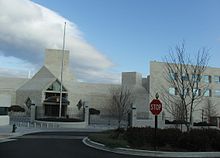Embassy of China, Washington, D.C.
| Embassy of China, Washington, D.C. Embassy of The People's Republic of China in The United States of America 中华人民共和国驻美利坚合众国大使馆 | |
|---|---|
 | |
 | |
| Location | Washington, D.C. |
| Address | 3505 International Place, N.W. |
| Ambassador | Cui Tiankai |
The Embassy of China in the U.S.A., Washington, D.C. is the diplomatic mission of China to the United States. It is located at 3505 International Place, Northwest, Washington, D.C., in the Cleveland Park neighborhood.
The embassy also operates Consulates-General in Chicago, Houston, Los Angeles, San Francisco, and New York City.[1]
The Ambassador is Cui Tiankai, who was appointed in April 2013. The previous ambassador was Zhang Yesui.[2]
History
The Qing Empire opened its first mission to the U.S. in 1875, with Chen Lanbin as Minister. From 1886 to 1893, the legation was located in Stewart's Castle on Dupont Circle.,[3] then under Minister Wu Tingfang in the former mansion of Thomas Franklin Schneider at 18th & Q Street, NW.
In 1902, the Qing legation moved to a purpose-built mansion designed by Waddy Butler Wood on 2001 19th Street NW. It is the oldest extant building erected in Washington by a foreign government, following the demolition in 1931 of the former British Legation on Connecticut Avenue, built in 1872.[4] This became the legation of the Republic of China following the fall of the Qing Dynasty in 1912. In 1935, the legation was upgraded to an embassy, and Alfred Sao-ke Sze became China's first ambassador to the U.S. The embassy remained in the same building until 1944, then moved to the former Fahnestock Mansion designed by Nathan C. Wyeth on 2311 Massachusetts Avenue NW (now the embassy of Haiti), where it stayed until the late 1970s.
When the US established diplomatic relations with the People's Republic of China, a liaison office was first established in 1973, led by Huang Zhen. It occupied two adjacent former apartment buildings at 2300 and 2310 Connecticut Avenue NW, and in 1979 became a fully-fledged embassy. These buildings were torn down in 2012 (except a 1922 façade on Connecticut Avenue) and are being replaced by an apartment house for Chinese embassy employees.[5]
The current building in the International Chancery Center was built in 2006-08 on a design by Pei Partnership Architects, with I. M. Pei as consultant.[6]
Controversy
In 2014 a proposal was made in the United States Congress to rename the street in front of the Chinese Embassy after the Chinese dissident Liu Xiaobo. This would make the embassy's new address "1 Liu Xiaobo Plaza".[7]
Gallery
-
Stewart's Castle on Dupont Circle, Qing legation 1888-93 (demolished in 1901)
-
Schneider Mansion on 18th and Q Street NW, Qing legation around 1900 (demolished in 1958)
-
Qing, then ROC legation/embassy on 2001 19th Street NW (now the Chinese Embassy condominiums)
-
Gibson Fahnestock House, ROC embassy 1944-1978 (now Embassy of Haiti)
-
Former PRC embassy on 2300 Connecticut Avenue NW (demolished in 2012)
See also
References
- ^ http://www.visarite.com/chnConsulate.htm
- ^ "Chinese Ambassadors to the United States of America". Embassy of the People's Republic of China in the United States of America. Retrieved 26 June 2014.
- ^ "Lost History: Stewart's Castle on Dupont Circle". Ghosts of DC. March 28, 2013.
- ^ James M. Goode (2003). Capital Losses: A Cultural History of Washington's Destroyed Buildings. Smithsonian. p. 264.
- ^ John Kelly (November 2, 2013). "Confused by the facade that overlooks Connecticut Avenue? Here's the story". Washington Post.
- ^ Suevon Lee (May 28, 2008). "China's new embassy in U.S. reflects growing clout". New York Times.
- ^ Beech, Hannah (25 June 2014). "Congress Votes to Rename Road by Chinese Embassy After Jailed Dissident". TIME Magazine. Retrieved 26 June 2014.
External links





